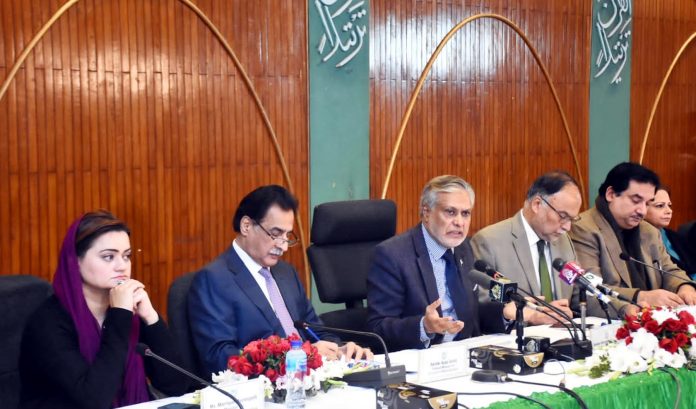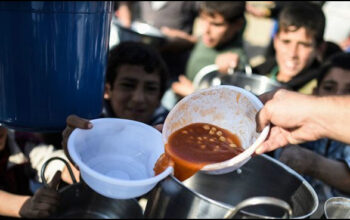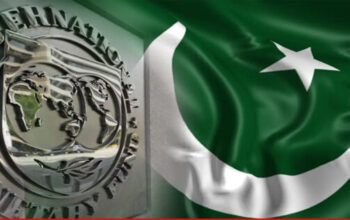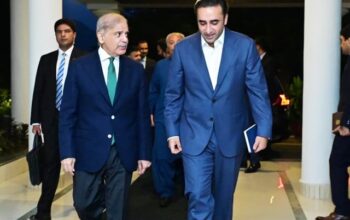A briefing paper released at the presser demolishes the PTI’s white paper by exposing claims made in it as barefaced lies designed to extract political advantage from economic hardship brought in by the party’s own misrule.
By Muhammad Ali.
ISLAMABAD: Describing former Prime Minister Imran Khan’s 42-month rule as worse than military dictator Yayha Khan’s, Minister for Finance Ishaq Dar Wednesday voiced hope that dollar inflows from multilateral and bilateral creditors and privatisation proceeds would be improved in the second half (Jan-June 2023) of the current fiscal year.
The Finance Minister was responding a white paper issued by Khan, the chairman of his own Pakistan Tehreek-e-Insaf (PTI), at Lahore the other day in a bid to weaponise the prevailing economic hardship, much of which is of his making, against the Pakistan Democratic Movement (PDM) government.
Dar, who assumed the charge of the Ministry of Finance in the cabinet of Prime Minister Shehbaz Sharif in September 2022, termed PTI’s White Paper on the economy as distorted and misleading to the masses because it used factually incorrect data without sharing proper perspective.
A Senator for PM Sharif’s Pakistan Muslim League – Nawaz (PML-N), the Finance Minister rejected all PTI’s claims and reiterated the government’s oft-repeated position that the economic dire straits Pakistan is in are the direct result of the mismanagement of the economy by Khan’s government, booted out by the Parliament in a vote of no confidence in April 2022.
He said that the government was considering a Flood Levy in order to discourage imports. The proposed Flood Levy is to be imposed through a Presidential Ordinance, expected within the next few days. It will also propose a Windfall Gains Tax on the banking sector that had earned PKR 100 billion extra profits through alleged manipulation in currency.
“Going forward, friendly countries have announced their support which will help manage forex reserves in the country”, the Minister told a media conference here at P Block on Wednesday.
Flanked by a gaggle of cabinet ministers and aides, the minister said that Saudi Arabia was going to provide financial assistance within the current month; and the 9th and 10th reviews of the International Monetary Fund (IMF) program could be clubbed because the time for 10th review has already arrived.
Now in his third stint at the helm of the ministry, the Finance Minister vociferously reiterated that Pakistan would not default at any cost. The veteran technocrat argued that the country required $32 billion over the current fiscal year to balance the books, which is doable as Pakistan had secured $35 billion in financing in 2017-18.
A briefing paper released at the presser exposed many of the claims made by the PTI white paper as outright lies. It began by setting the record straight on the fiscal deficit, which the PTI incorrectly claimed it reduced from 7.6 percent of GDP in FY 2018 to 5.5 percent in FY 2019.
In reality, fiscal deficit stood at 5.8 percent of GDP in 2018 and shott up to 7.9 percent in FY 2019, the first fiscal year under the PTI government. The revenue collection figures the white paper quoted to support the above numbers were also shown to be falsified.
Instead of increasing from PKR 3.7 trillion in FY 2018 to PKR 5.5 trillion in FY 2019, revenue collection by the Federal Board of Revenue (FBR) slipped over the year by 0.4 percent, decreasing to PKR 3.83 trillion in FY 2018 from PKR 3.84 trillion inFY2018.
The 30-page slide deck methodically demolishes the whole narrative of PTI ushering in the good times by taking apart one by one every single point made in the white paper. It then presents a comparison of economic performance under PTI and PML-N, again giving the lie to Khan’s tall claims of having worked wonders.
The briefing paper also shows how Pakistan’s debt shot up at a dizzying pace under PTI without the commensurate productivity or development jump, how the energy sector circular more than doubled, and how economic mismanagement under Khan had put the country on a path to default.
The paper says Pakistan is passing through a difficult forex reserves position due to the PTI government’s policies, but adds that the PDM government is making all possible efforts to stabilise the economy.
It showcases the government’s commitment to the welfare of the less fortunate by showing how public spending on safety nets has substantially increased in the current fiscal, and how the government has spent PKR Rs 70 billion to provide flood relief cash assistance to 2.7 million beneficiaries through BISP.
What the briefing paper says
The PTI Claims that in 2018 the economic growth plummeted to 1.5 percent and inflation rose to 10.5 percent. The minister said this statement is misleading. In FY2018, the economic growth was at 6.10 percent, while during the first year of the PTI government i.e FY2019, growth declined to 3.12 percent. Inflation was 4.7 percent in FY 2018 (old base 3.9 percent) while it rose to 6.8 percent (old base 7.3 percent) in FY 2019
PTI Claims that in 2018 discount rate increased by 325 basis points, however, when the PTI government assumed charge in August 2018, the policy rate was 7.5 percent. It increased to 13.25 percent by July 2019 by 575 bps, so the statement “increase in the discount rate by 325 bps” is incorrect and not true.
The PTI claims that 5.5 million new jobs created during FY2019-22 but the actual data shows that only 3.2 million new jobs were created during the same time period.
The current account deficit which increased in PML (N) led tenure mainly because of 26 percent import of machinery equipment, massive investment in energy projects to eliminate load shedding and for security requirements but the PTI led regime posted CAD to the tune of $17.3 billion in 2021-22 without taking any major initiatives.
He said exports remained virtually the same in PML(N) tenure due to massive compression in global commodity prices. Exports increased during the last year of PTI government due to commodity super cycle, the value effect overrode the volume effect, massive devaluation and un-limited distribution of TERF at 1 percent with a fiscal cost for the economy.
The GDP Growth during PML (N) tenure ranges from 4.05 to 6.10 percent while growth ranges from -0.94 to 5.97 percent in PTI tenure. The GDP in-terms of $ increased by $112 bn in PML (N) tenure while in PTI tenure it increased by only $ 61 bn in 42- month rule.
The Per Capita income during PML (N) recorded 27.3 percent growth ($ 1389 – $ 1768) while in 42-month tenure of PTI the per capita income reached $1798 only.
Investment as a percent of GDP was higher during PML(N) compared to PTI tenure as it stood at 17.1 percent of GDP in 2018 against 15.1 percent in FY2022.
PTI’s claims of lost jobs of 1.5 million in the textile industry & many more in other industries & professions is based on perception having no supporting evidence.
PTI’s claims 5.5 million new jobs were created during FY2019-FY2022 which is incorrect
Only 3.2 million new jobs were created during 2019-2021 according to Labour Force Survey. The PTI attempted to mislead the masses by claiming the increase of 22.5 percent in unemployment. This is not based on facts as no Labour Force Survey has been released by PBS for FY 22 and beyond.
During PML(N) tenure, maximum CPI was 8.6 percent and minimum stood at 2.9 percent while in PTI tenure, maximum CPI reached 12.2 percent and minimum stood at 6.8 percent. During PML(N) tenure, maximum food inflation was 9.0 percent and minimum stood at 2.1 percent while in PTI tenure, maximum food inflation reached 13.6 percent and minimum stood at 4.6 percent.
FBR revenue as a percent of GDP was on increasing trajectory during PML(N) tenure (9.8 percent), however, it declined during PTI tenure (9.2 percent).
Import as a percent of GDP during PML(N) tenure was 15.6 percent, however, it jumped during PTI tenure to 18.8 percent which led to severe macroeconomic imbalances.
Regarding twin deficits, the minister said that the fiscal deficit averaged 5.2 percent of GDP during PML (N) against 7.2 percent of GDP on average during PTI regime.
The trade deficit deteriorated during PTI tenure by 31 percent and reached to $29 bn. Trade Deficit improved by 26 percent from $17.4 bn to $12.8 bn during the first 5 months of the current FY. The Current Account Deficit improved by 57 percent from $7.2 bn to only $3.1 bn during the first 5 months of the current FY 23.
The policy rate reduced to a historic low at 5.7 percent in FY2016 from 10 percent at the end of FY2014 due to improved macroeconomic indicators. In August 2018, SBP adopted a policy rate reversal.
In FY2022 due to macroeconomic imbalances including higher imports, mounting current account deficit, and soaring inflation, the policy rate increased to 13.7 percent.
In PTI’s tenure, policy rate increased by 7.25 percent (6.5 percent to 13.75 percent); whereas in PML(N) current year it has increased by 2.25 percent only (13.75 percent to 16 percent).
For Social Safety Nets, the minister said that for FY2023, Budgetary allocation of BISP has been increased to PKR 364 billion and the government has planned to expand the scope of BISP and increase the number of beneficiaries upto 10 million.
The government has also included 500,000 more people from Balochistan in BISP, which would cover around 65pc of the population of the province. For this purpose, more BISP centres are being established in the province.
In addition to above, the government provided flood relief/cash assistance of PKR 70 billion to 2.7 million beneficiaries through BISP.
He said that total public debt and liabilities stood at PKR 29.8 trillion in June 2018 while under PTI regime it went up to PKR 53.549 trillion, highest ever increase in total public debt and liabilities.
Copyright © 2021 Independent Pakistan | All rights reserved




